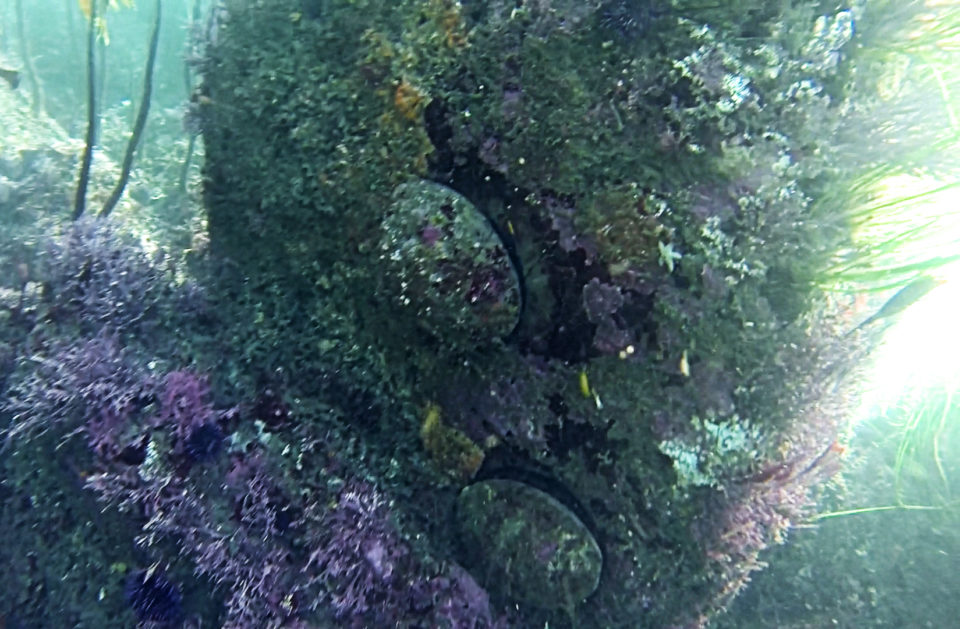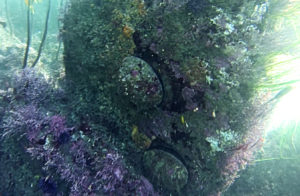Here are two videos Jack Likins recently took while diving near Arch Rock Road in The Sea Ranch. He entitled one “the good” and the other “the bad.” Jack wrote, “The one clip shows some of the good, almost environmental normal, areas with healthy vegetation and sea life; and the other clip shows the same general area where the Sea Urchins are taking over.” Jack tells me that Sea Urchins have taken over the deeper waters, twenty feet and deeper. Here's a photo taken by Roger Rude of several healthy Abalones.
The Good, a healthy intertidal zone by Jack Likins
And here is the "bad," the ocean floor taken over by purple Sea Urchins.
Jack wrote further, “The remaining Abalone have moved into depths less than 20 feet where there is kelp [food] that the urchins haven't eaten. I don't think the urchins like the shallower water because they can't hang onto the bottom in the rougher shallow and intertidal areas. I'm not seeing much bull kelp but am seeing boa, giant and palm kelps, mostly in the shallower water. I do see some short stalks of bull kelp underwater but it seems to me that the bull kelp is showing itself on the surface later and later each year, so we'll have to wait to see if it gets to the surface before the urchins eat it this year.”
There is some bull kelp to be seen off the north end of Gualala, but it is sparse. We hope the ocean can get back in balance. We know Sea Stars are recovering, so there's good news there.
Thanks to Jack for allowing me to share his videos with you here, and thanks to Roger for allowing me to share his photo with you here.
Sunny and warm at our place in Anchor Bay, though fog covers most of the ocean.


Ryan
Hi Jeanne,
It appears that both clips are of "the bad". Would you mind uploading "the good"?
Many thanks!
Jeanne Jackson
Post authorhmm, for some reason the "bad" video shows below the link to the "good" video. Not sure what I did wrong. I have deleted the video and just left the link to see the "good." Hope this does the trick. Thanks for letting me know.
Sita D Milchev
I think the pictures are important to see what's going on in the sea for those of us who don't dive and don't understand the Sea Urchins and kelp problem along with the Abalone.
Jeanne Jackson
Post authorI totally agree, Sita!
SeaRanchAbaloneBay
THURSDAY, SEPTEMBER 19, 2019!!! LEARN MORE HERE:
http://www.opc.ca.gov/2019/05/red-abalone-management-strategies-integration/
We look forward to your participation in this week’s Project Team meeting (webinar) to continue discussing a revised draft management strategy and de minimis fishery strawman proposals for the north coast recreational red abalone.
An agenda and support materials are now available (listed and linked below) and posted to the Ocean Protection Council’s project webpage (here). We kindly ask that you review the high-priority support materials in advance of the webinar as these materials will be the focus of the discussion. Additional background materials that will also be referenced during the webinar build upon the next steps identified from the August 27 Project Team meeting and complement the information shared in the high priority materials.
High-Priority Support Materials
Agenda (here)
Updated high-level summary of revised draft management strategy (here)
Technical report on revised draft management strategy (here)
Key Themes Summary from August 27 Project Team meeting (here)[1]
Draft de minimis fishery proposals (here)
Background Materials
Updated, proposed next steps for modelers (here)
Updated, glossary of key terms (here)
Data stream comparison table - Updated August 2019 (here)
Updated, Project Team work plan (here)
De minimis fishery ideas and concepts received from the public (here - listed under “Project Team Proposals”)[2]
[1] Please note that the Key Themes Summary from the August 27 Project Team meeting is now available and has been listed above as background material for the upcoming meeting. This document is not intended to act as a transcript but rather capture the topics, key questions, feedback, and recommendations that emerged from the conversation. The final summary has been reviewed for accuracy and content by Project Team participants who attended the meeting on August 27.
[2] The Administrative Team received two additional comment letters/proposals from members of the Project Team following the August 27 Project Team meeting. In an effort to support ongoing idea generation and open lines of communication, the Administrative Team has removed the deadline for the Project Team to receive proposals. Please note that the Project Team’s ability to respond to new proposals after the September 2019 meeting may be limited.
A reminder of meeting details:
Recreational Red Abalone FMP Project Team
Meeting #4: Revised Management Strategy & Continued Discussion on De Minimis Fishery
Thursday, September 19, 2019 | 9:00 am - 12:30 pm PST
Screen sharing: https://www.uberconference.com/strategicearth
Dial-in number: 424-228-8722, no pin needed
We would be most appreciative if you could share this invitation with your peers and constituents via your newsletters, blogs, social media, and other communications outlets.
We look forward to a productive conversation later this week. Please do not hesitate to reach out with any questions, comments, or concerns.
All our best,
Rachelle and the Strategic Earth Team
Project Team Coordination & Facilitation Support
Recreational Red Abalone FMP Project Team meetings are convened by the Administrative Team, with membership from the California Department of Fish and Wildlife, The Nature Conservancy, Ocean Protection Council, Fish and Game Commission, Tribes and Tribal communities, and the Red Abalone fishing community. You are receiving this invitation email because you expressed an interest in receiving updates about and invitations to Red Abalone FMP Project Team discussions. Should you wish to be removed from this mailing list, please email hello@strategicearth.com.